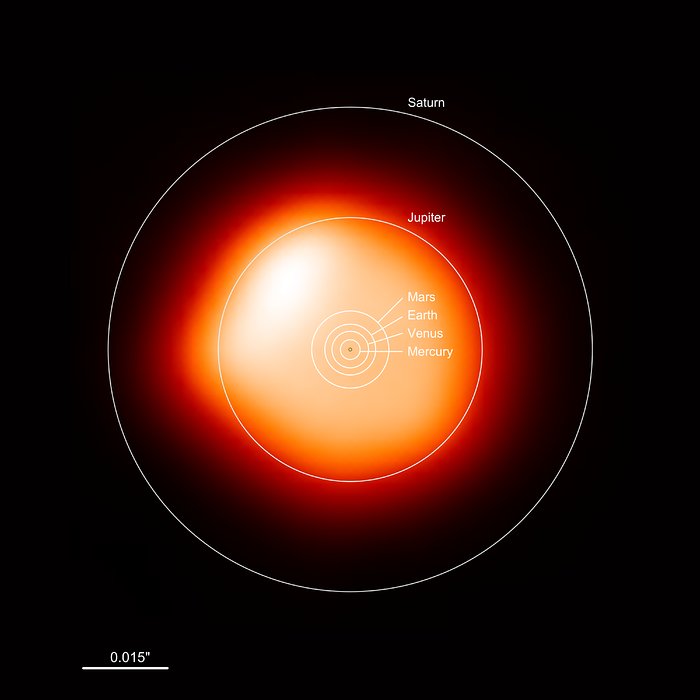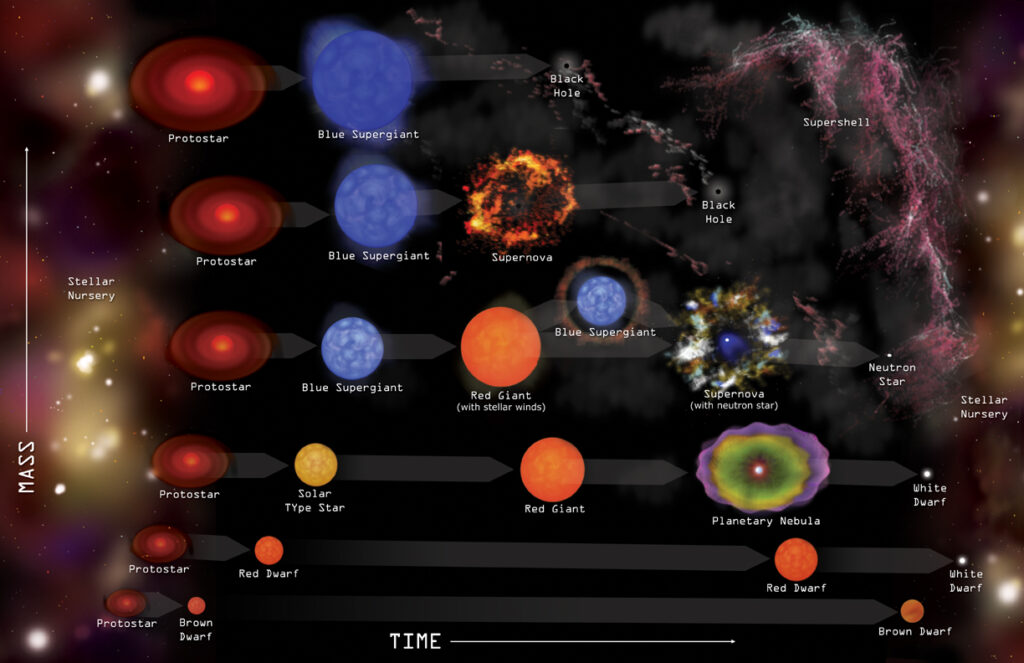
Betelgeuse is a red giant star with a radius of 617,100,000 km — a whopping 887 times the Sun’s radius. To have an idea of the size, Orion’s star is so big it could envelop Jupiter’s entire orbit (depicted in the image below).

In December 2019, astronomers noticed a sudden drop in the star’s brightness. The observations continued until it reached a minimum in February 2020. The first hypothesis that came to everyone’s mind was that the star was in its final days and would explode to a Type II Supernova, which seemed plausible due to its size and characteristics.
Betelgeuse is a massive and very hot star, so it burns its fuel faster than smaller stars. As a result, red giants like Betelgeuse have shorter lives (Betelgeuse is only 10 million years old while our Sun is 450 times older) and it is estimated that it has about 100,000 years left.
When a star this size explodes into a supernova, its brightness reaches a maximum and then stabilizes as it decreases in brightness. If Betelgeuse were to indeed turn into a supernova, we’d see this in the night sky as something having 10% of the Moon’s brightness — but at its peak, the brightness will even outshine the moon in the first days of high luminosity.
However, scientists have suggested that dust in front of our point of view made it appear less bright. The Hubble space telescope observations of the sudden dimming suggested that mass ejection from the star created a bubble of gas that quickly cooled down and the dust became what we can imagine as a shadow in our line of sight, which made it appear less luminous.
After the (metaphorical) dust had settled, Betelgeuse still did not turn into a supernova. So what did it actually do?
What is the dust all about?
Another group decided to check using a submillimeter telescope. Submillimeter astronomy observes a specific part of the electromagnetic spectrum: between far-infrared and microwave wavelengths.
These parts of the spectrum help researchers detect the presence of water vapor, as well as molecular oxygen and other molecules. Observations with submillimeter telescopes are ideal for detecting the ingredients which form stars and planets.

Whenever a submillimeter telescope points to nebular dust, the image is very bright due to the dust itself. The James Clerk Maxwell Telescope didn’t have a significant signal from the ‘dust’ ejected by Betelgeuse, which essentially invalidated the dust hypothesis. So it wasn’t a supernova event and there wasn’t any dust — so what could have caused Betelgeuse’s loss of luminosity?
Another giant goes dark
A more recent study looked at another giant star, finding that this type of mass ejection event may be common for massive stars than we thought, and the missing piece is a gas bubble around the star. These gas bubbles which are ejected may be good candidates to understand more about the building blocks of the formation of future stars.
VY Canis Majoris (VY CMa) is a hypergiant located in the Canis Major constellation, almost twice as large as Betelgeuse. Data collected with the Hubble telescope showed that a similar variability of brightness from Betelgeuse — in other words, what happened with VY CMa likely also happened to Betelgeuse.
This research compared the recent dimming of the VY CMa with historical data from the 1880-1890 and 1920-1940 periods. The Canis Major’s star has a longer period of alternating from maximum to minimum brightness. This could be related to the size of the object: a larger star requires a longer period of dust ejection, consequently, more dust escapes it.
It was a disappointment for many astronomers who were hoping to see something spectacular — but instead, more questions than answers seem to have emerged about the behavior of these supernovae. From now on, we wait for further research and observation to better understand red giants mass ejections.






